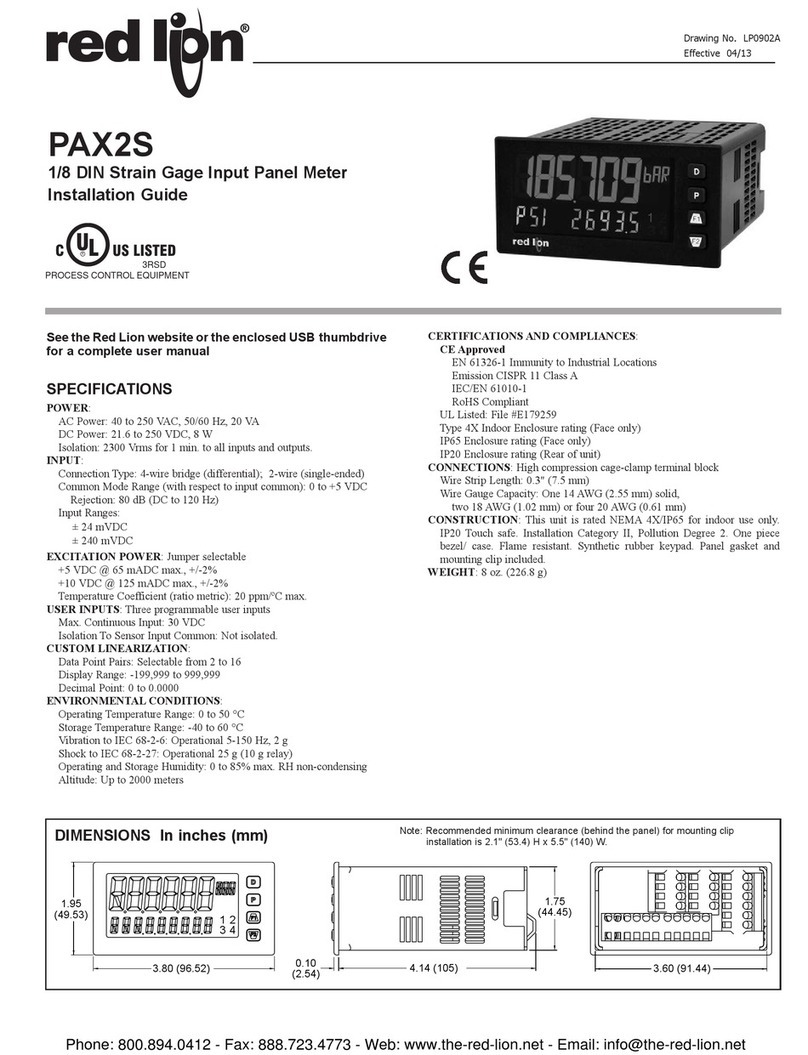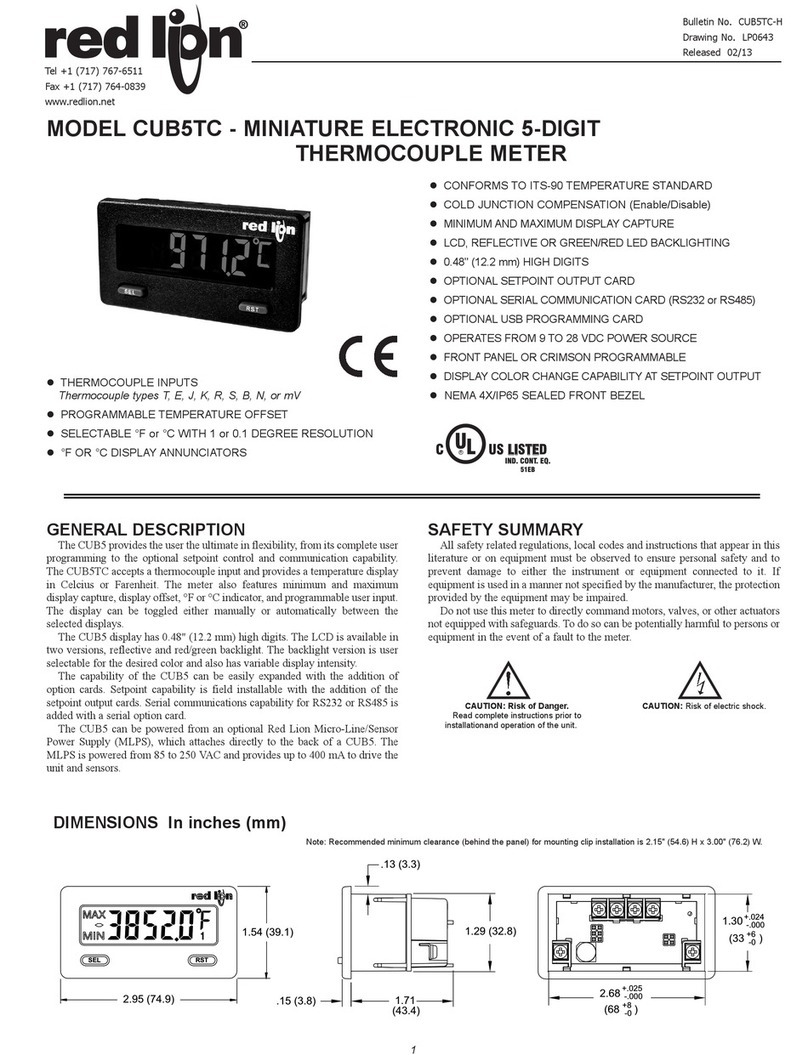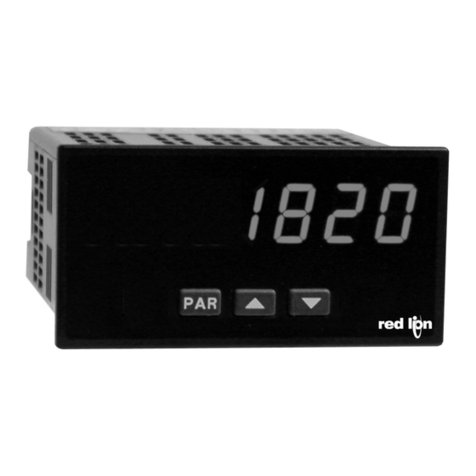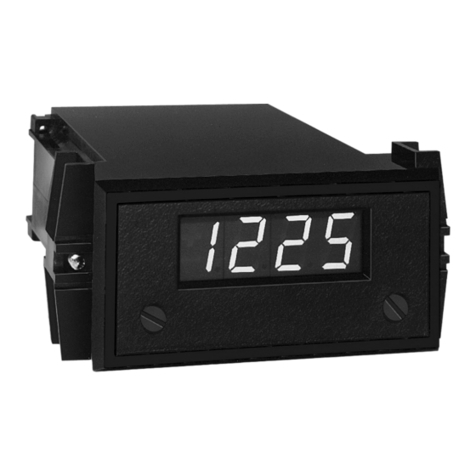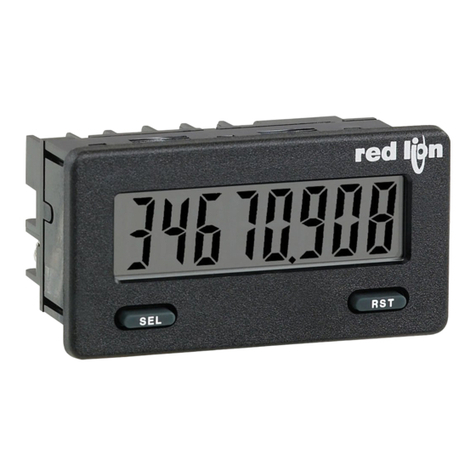
The meter has a jumper and switches, which must be checked and/or changed
prior to applying power. To access the power switch and the jumper, remove the
meter base from the case by firmly squeezing and pulling back on the side rear
finger tabs. This should lower the latch below the case slot (which is located just
in front of the finger tabs). It is recommended to release the latch on one side,
then start the other side latch.
Power Selection Switch
Caution: Insure the AC power selection switch is set for the
proper voltage before powering-up the meter. The meter is shipped
from the factory in the 230 VAC position.
Mode Selection Jumper
Inside the meter is also the Mode Selection Jumper, located near the display
board. This jumper will select operation in the 6 digit mode or 5 digit
(chronometer) mode. When the jumper is positioned toward the display board,
the unit will be in the 6 digit mode of operation. With the jumper positioned
away from the display board, the meter is in the 5 digit (chronometer) mode.
This unit ships from the factory in the 6 digit mode.
Set-Up DIP Switches
A DIP switch is located at the rear of the meter,
and is fully accessible when the unit is in the case.
It is used for the selection of the input parameters
and program disable. For the correct input setup,
refer to 3.2 Input Wiring.
SWITCH 1
SNK.: Adds internal 7.8 Kpull-up resistor to + 12 VDC, IMAX = 1.9 mA
SWITCH 2
SRC.: Adds internal 3.9 Kpull-down resistor, 8 mAmax. @ 30 VDC max.
SWITCH 3
HI Frequency: Removes damping capacitor and allows max. frequency.
LO Frequency: Limits input frequency to 50 Hz and input pulse widths
to 10 msec.
SWITCH 4
LOGIC: Input trigger levels VIL = 1.5 V max.; VIH = 3.75 V max.
MAG: 200 mV peak input (must have SRC on)
SWITCH 5
Enable Programming: Enables programming through the front panel buttons
Disables Programming: Disables the front panel buttons from any
programming changes
SWITCH 6
Enable Averaging: Enables moving windows averaging feature.
Disable Averaging: Disables moving windows averaging feature.
4
2.0 SETTING THE JUMPER AND SWITCHES
3.0 WIRING THE METER
WIRING OVERVIEW
Electrical connections are made via screw-clamp terminals located on the
back of the meter. All conductors should conform to the meter’s voltage and
current ratings. All cabling should conform to appropriate standards of good
installation, local codes and regulations. It is recommended that the power
supplied to the meter (DC or AC) be protected by a fuse or circuit breaker.
When wiring the meter, compare the numbers embossed on the back of the
meter case against those shown in wiring drawings for proper wire position. Strip
the wire, leaving approximately 0.3" (7.5 mm) bare lead exposed (stranded wires
should be tinned with solder.) Insert the lead under the correct screw-clamp
terminal and tighten until the wire is secure. (Pull wire to verify tightness.)
EMC INSTALLATION GUIDELINES
Although this meter is designed with a high degree of immunity to Electro-
Magnetic Interference (EMI), proper installation and wiring methods must be
followed to ensure compatibility in each application. The type of the electrical
noise, source or coupling method into the meter may be different for various
installations. The meter becomes more immune to EMI with fewer I/O
connections. Cable length, routing, and shield termination are very important
and can mean the difference between a successful or troublesome installation.
Listed below are some EMC guidelines for successful installation in an
industrial environment.
1. The meter should be mounted in a metal enclosure, which is properly
connected to protective earth.
2. Use shielded (screened) cables for all Signal and Control inputs. The shield
(screen) pigtail connection should be made as short as possible. The
connection point for the shield depends somewhat upon the application.
Listed below are the recommended methods of connecting the shield, in order
of their effectiveness.
a. Connect the shield only at the panel where the unit is mounted to earth
ground (protective earth).
b. Connect the shield to earth ground at both ends of the cable, usually when
the noise source frequency is above 1 MHz.
c. Connect the shield to common of the meter and leave the other end of the
shield unconnected and insulated from earth ground.
3. Never run Signal or Control cables in the same conduit or raceway with AC
power lines, conductors feeding motors, solenoids, SCR controls, and
heaters, etc. The cables should be run in metal conduit that is properly
grounded. This is especially useful in applications where cable runs are long
and portable two-way radios are used in close proximity or if the installation
is near a commercial radio transmitter.
4. Signal or Control cables within an enclosure should be routed as far as possible
from contactors, control relays, transformers, and other noisy components.
5. In extremely high EMI environments, the use of external EMI suppression
devices, such as ferrite suppression cores, is effective. Install them on Signal
and Control cables as close to the unit as possible. Loop the cable through the
core several times or use multiple cores on each cable for additional protection.
Install line filters on the power input cable to the unit to suppress power line
interference. Install them near the power entry point of the enclosure. The
following EMI suppression devices (or equivalent) are recommended:
Ferrite Suppression Cores for signal and control cables:
Fair-Rite # 0443167251 (RLC# FCOR0000)
TDK # ZCAT3035-1330A
Steward # 28B2029-0A0
Line Filters for input power cables:
Schaffner # FN610-1/07 (RLC# LFIL0000)
Schaffner # FN670-1.8/07
Corcom # 1 VR3
Note: Reference manufacturer’s instructions when installing a line filter.
6. Long cable runs are more susceptible to EMI pickup than short cable runs.
Therefore, keep cable runs as short as possible.
7. Switching of inductive loads produces high EMI. Use of snubbers across
inductive loads suppresses EMI.
Snubber: RLC# SNUB0000.
REAR TERMINALS
FRONT DISPLAY
115
INPUT SET-UP
DIP SWITCHES
230
POWER
SELECTION
SWITCH
MODE SELECTION JUMPER
6
5
4
3
2
1
ON
DIS PGM
DIS AVE
MAG
LO Freq.
SRC.
SNK.
EN PGM
EN AVE
LOGIC
HI Freq.
Not Active
Not Active












